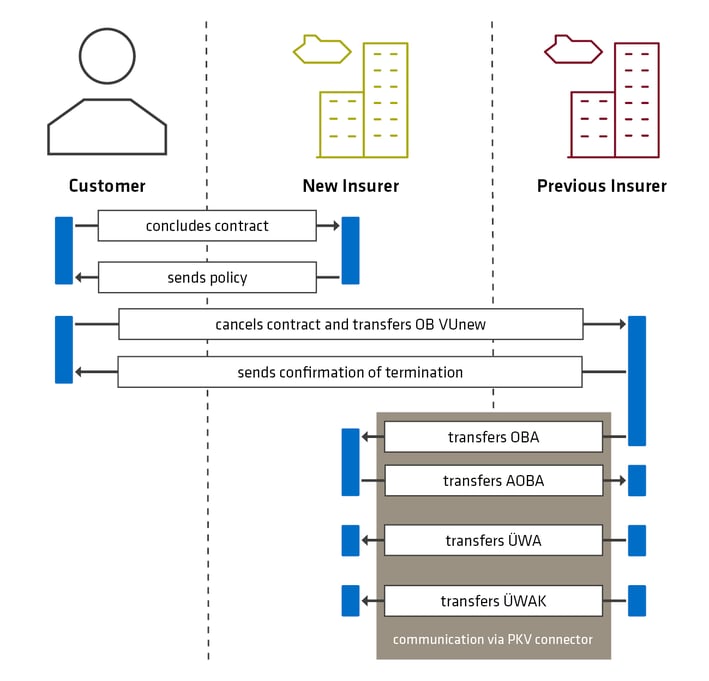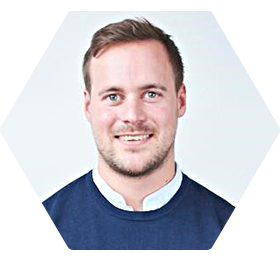The German private health insurance (PKV) sector is undergoing major changes. The old HOST application is getting more expensive over time - increasing maintenance costs are mainly due to outdated servers and hard-to-find Cobol developers. As a result, many health insurance companies are choosing to introduce a new generation of software to the company to replace the old systems. In addition, there are other issues that are well known in the industry and will also be addressed in this move. Be it further digitization, the consideration of new findings in user experience (ux) and user interface (ui) for interfaces, a high degree of straight through processing or even the outsourcing and processing of entire process chains in the full-service model.
Project procedure for the replacement of legacy systems
In most cases, the first step in replacing a legacy system is to focus primarily on the main software used frequently by workers, such as inventory management systems and benefit processing systems. Marginal processes - i.e. processes that do not take place directly in the main system - are usually only addressed at a later point in time. The consequence is that the old (partial) process remains largely unchanged.
Effects of legacy processes
Often, however, these legacy peripheral processes must continue to interact with inventory and performance systems to deliver the desired functions or results. This consequently results in a mixture of old peripheral processes/peripheral software combined with software built to new standards. The side effects of such a system mixture are individual solutions with high maintenance costs later on, which furthermore do not correspond to the standard of the new system, for example with ux/ui.
Advantages of a unified IT landscape
However, the aim should be to create a uniform work platform for the workers in order to ensure the basis of work efficiency. In addition, intuitive processing is usually better facilitated in the new systems. The advantages of this are a targeted, faster training of new employees, the reduction of later costs in maintenance and the mapping of marginal processes customary to the market. In the medium term, this will help to avoid cost drivers and increase acceptance of the peripheral systems among workers.
The transfer value process as an example of a peripheral process
As an example of a peripheral process, one can cite the process of processing the transmission values. Carryover values accrue to each insured person during the policy period of a substitutive plan. These transfer values consist of pension reserves that have been formed and are usually calculated in the policy management system and stored in the insured person's file. If an insured person with this substitutive tariff changes the insurance company (VU), the deposited transfer values are transferred from the previous insurance company (VUalt) to the new insurance company (VUneu). Here, the outgoing transfer values are written to an interface of the Inventory Management system. The further process takes place outside of the main system (= peripheral process).
The PKV connector in the machine-supported switching process (MUW)
Before transferring the transfer values, you can use notification categories to compare the evaluation groups to ensure that the new insurance company credits the transfer values to the required insurance contract and the correct person. This is done via the PKV connector provided by the PKV association. This platform provides for a standardized process flow: An ordinal term request (OBA) is followed by an ordinal term request response (AOBA), which is followed by the transmission value imputation (UeWA) message. Incoming notification categories can be viewed in the PF connector and outgoing notification categories can be created directly in the PF connector. In addition, the PKV connector serves the PKV directory, a standardized directory structure that is stored as a file interface at each insurance company. Here the incoming or outgoing message types are collected as xml files for further processing. Outgoing notification categories are forwarded from this PKV directory to the PKV connector, while incoming notification categories flow into internal processing.
MUW - process

Implementation at the insurance company and advantages of the MUW Gateway
The insurance company now has the choice to handle the process manually, e.g. via PKV connector, or to aim for a (partially) automated process with the help of the PKV directory. With regard to the problem, a high degree of automation and consistent interfaces are desirable. This can be achieved with the adesso module "MUW Gateway". In the case of an incoming OBA, the gateway compares the evaluation groups in the partner system and in the inventory management system and creates a resulting outgoing AOBA with the corresponding status. The following incoming UeWA can be automatically credited to an insured person of a contract. In case of termination of a tariff entitled to value transfer, the designated interface is supplied and the MUW Gateway creates an outgoing transfer value transaction with message type "outgoing OBA". In case of an incoming AOBA with status "Ok" or "Correction", an outgoing UeWA is created. When sending this notification type, a retention due to contribution arrears can also be taken into account. The interfaces for disbursement - for payment of the transfer values to the new insurance company and printing, as well as for notification of the confirmation of the transmitted transfer values to the policyholder - are supplied. A control of the process to a workflow interface is provided for unexpected message categories or evaluation groups that do not automatically match. The entire process can be traced at any time on the MUW Gateway interface. The interface is coordinated with the interface from in|sure Health Policy, the contract overview of which is also used to move to the transmission value process in the MUW-Gateway.
Advantages of replacing the MUW peripheral process
The advantages of using the MUW gateway are a high degree of automatic processing, targeted control and the mapping of the transfer value process in a specially designed tool, so that the considerable sums transferred between the insurance companies can be processed clearly.
Decision to introduce peripheral processes
The decision to include peripheral processes in the implementation project depends on the resulting benefits. A replacement of frequently occurring manual processes can lead to a high acceptance of the main system by the workers. If coordinated standard software is available for the peripheral processes, the implementation effort is usually manageable compared to the benefits. In this way, a possibly complex and non-transparent processing can be replaced with little effort. Therefore, it is important for us, as adesso, to also align peripheral processes with the main software and to provide solutions for the private health insurance market. Feel free to contact us!

